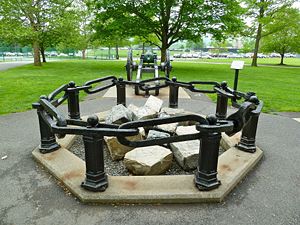Great Chain - West Point
 | |
 | |
The Great Chain
A 500 yard long iron chain built for Patriot forces during the Revolutionary War to block British ships from sailing up the Hudson River to Albany. Had the British been able navigate the full length of the Hudson they could have cut the Colonies in two. The "Great Chain" was placed between West Point and Constitution Island at a point where the Hudson River makes an "S" curve and sailing ships were force to slow down and tack, making them vulnerable to shore batteries.
In conjunction with the placement of the chain, a series of fortifications were established at both the West Point end and on the Constitution Island end of the chain. Collectively these fortifications came to be known as Fortress West Point. While the goal was to stop British ships from controlling the Hudson, the chain was considered the key element in the defense and many of the fortifications directly protected the chain.
The chain itself was fastened on the West Point side of the river at what became known as Chain Cove and directly protected there by Chain Battery, Battery Lanthorn and from the plain above by Fort Arnold, later renamed Fort Clinton after Benedict Arnold's treachery was discovered. The southern river approaches to the chain were covered by Water Battery - West Point, South Battery and Fort Clinton.
The chain was fastened on Constitution Island at a southwest inlet and protected there by a series of batteries including Romans Battery, Marine Battery, Hill Cliff Battery and Gravel Hill Battery|Gravel Hill Battery. All of the river facing gun batteries were protected from land side attack by a ring of forts, redoubts and support batteries.
The chain was first connected across the river on 30 April 1778 under the direction of Captain Thomas Machin. The first year a parallel log boom was also deployed 300 feet south of the chain as a buffer but it sufferd from rot and was discontinued in subsequent years. From 1778 until 1783 the chain was disconnected in the late fall, refurbished over the winter with new log booms and reconnected in the spring when river ice was no longer a threat. The chain was not deployed in the spring of 1783 signalling to all that the war was at an end.
The Chain
In early February 1778 Captain Thomas Machin contracted with Peter Townsend of Sterling Ironworks, Warwick, New York, to produce the chain at a cost of about $60,000 with a delivery date of 1 Apr 1778. This was a massive order for the time and the company was asked to "to keep seven fires at forging and ten at welding” 24 hours a day to complete the order within the eight week timeframe.
The chain was to be about 500 yards long composed of two foot links each weighing an average of 114 pounds each. A swivel was to be inserted every 100 feet and a clevis inserted for every 1,000 pounds of chain. This required over 750 chain links, eight swivels and 80 clevises plus anchors, staples and other hardware. The chain was assembled in sets of nine (or 10) links placed on a three (or four) log boom and stapled to the boom with iron staples. Fifty-three sets were required for the completed chain. The sets were assembled at New Windsor about nine miles north of West Point, and floated downstream to Moore's House for final assembly. The assembled chain was brought into the two anchor locations with large capstans built especially for the task. When fully emplaced the chain was probably anchored to large log cribs filled with rock.
See Also:
Sources:
- Roberts, Robert B., Encyclopedia of Historic Forts: The Military, Pioneer, and Trading Posts of the United States, Macmillan, New York, 1988, 10th printing, ISBN 0-02-926880-X, page 591.
- West Point Fortifications Staff Ride Note Cards, 3rd ed, USMA History Department, January 1994 changed 1998 and 2008, Pdf, 82 pages, page 27-28.
- Boynton, Edward C., The History of West Point, D. Van Nostrand, New York, 1864 (public domain)
Links: